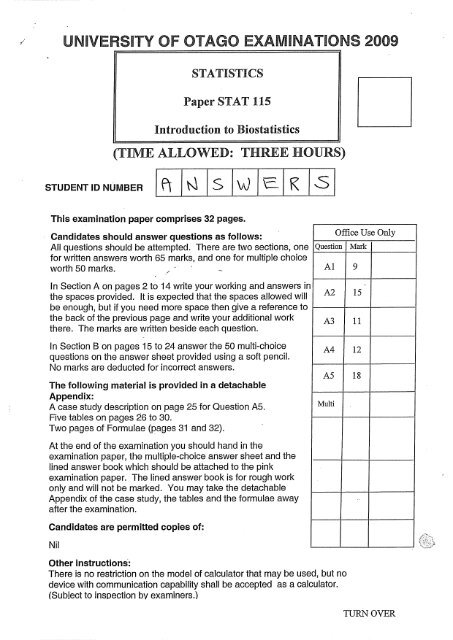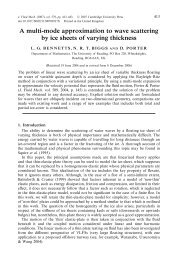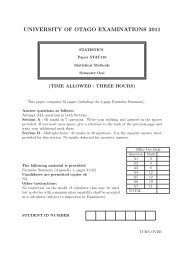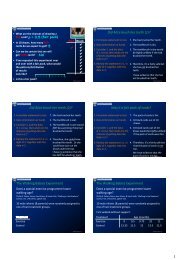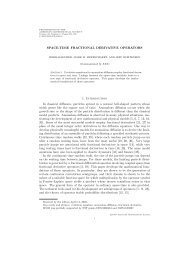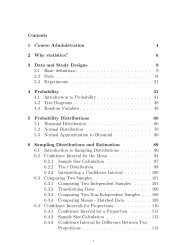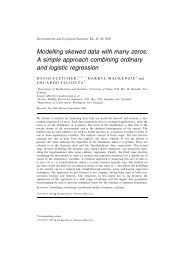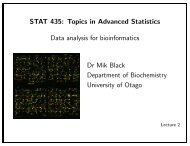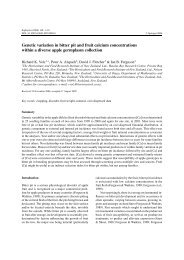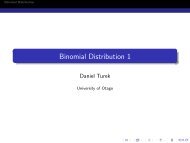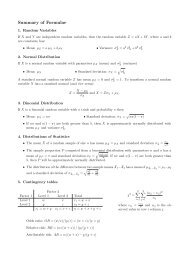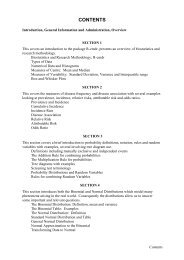Revision 2009 Exam paper, solns
Revision 2009 Exam paper, solns
Revision 2009 Exam paper, solns
- No tags were found...
Create successful ePaper yourself
Turn your PDF publications into a flip-book with our unique Google optimized e-Paper software.
25The answers provided below are model answers which include explanations intended tosupplement material provided in lectures. You would not necessarily be expected to give the samelevel of detail in your answers on an exam to receive full marks.INFORMATION FOR QUESTION A5 FROM <strong>2009</strong> STAT115 FINALIt is known that maternal smoking during pregnancy leads to increased risk of illness ordeath of the baby very early in life. It has been proposed that the smoking also affects thebrain of the foetus, but the consequences of this are unknown. A study was carried out toassess the effects of a mother smoking during pregnancy on consequent behaviouralproblems in the child at 18 months of age.Children born in Rotterdam between April 2002 and January 2006 were enrolled in thestudy. A total of 6395 children were enrolled in the study. Of these 1,755 withdrew duringfollow-up leaving 4640 children available for inclusion in the analysis.Information about mothers smoking during pregnancy was obtained from a structuredquestionnaire and categorized into ‘never smoked’, ‘quit before pregnancy’, ‘quit duringthe first 3 months of pregnancy’ and ‘continued smoking’.Child behavioural problems were obtained through a standardized checklist whichclassified children as ‘behavioural problems’ or ‘no behavioural problems’.Table 1. Association between maternal smoking and child behavioural problems at age 18months.UnadjustedAdjusted•Odds ratio (95%confidenceinterval)p-valueOdds ratio (95%confidenceinterval)p-valueMaternal smokingNever smoked 1.0 1.0Quit before pregnancy 0.75 (0.56 – 1.03) 0.07 0.81 (0.58 – 1.13) 0.22Quit during first 3months of pregnancy0.86 (0.57 - 1.28) 0.45 0.89 (0.59 – 1.36) 0.60Continued smoking 1.60 (1.22 – 2.10) 0.001 1.08 (0.80 – 1.47) 0.61• Adjusted for ethnicity, maternal education, paternal education and family incomeA5. REFER TO THE CASE STUDY DESCRIPTION ON PAGE 25
(a) (3 marks) Interpret the unadjusted odds ratios in Table 1 on page 25.Interpretation:The odds ratios for quit before pregnancy and quit during the first 3 months ofpregnancy are both less than 1, indicating that the odds of behavioural problems werelower in these groups than in those who had never smoked.Children whose mothers had continued to smoke during pregnancy had 1.6 times theodds of having behavioural problems as compared to children whose mothers had neversmoked.(b) (3 marks) The 95% confidence interval for ‘continued smoking’ is (1.22 - 2.10).Explain the information contained in this confidence interval, and how you wouldinterpret this confidence interval.Explanation:There is a 0.95 probability (equivalently, a 95% chance) that the interval (1.22 – 2.10 )contains the true odds ratio comparing behavioural problems in children whose mothersmoked during pregnancy to those whose mothers had never smoked. This interval is entirelyabove 1, so we conclude there is evidence that there is an increased odds of behaviouralproblems in children of mothers who smoke during pregnancy.[Note: When an epidemiologist asks if chance is a likely explanation for the findings, asin question 4 of the homework, you can answer the question by either discussing thep-value and/or the confidence interval. Here chance is not a likely explanation for thefindings, because the confidence interval excludes 1 (the null value).](c)(3 marks) The p-value for ‘continued smoking’is 0.001. Explain the informationcontained in this p-value and how you would interpret it.Explanation:We will assume this is a two sided p-value. (Most published studies give two sidedp-values.) If (in the population we sampled from) there is no association betweensmoking during pregnancy and child behavioral problems then there is a 0.001probability of observing an odds ratio of 1.6 or more extreme. Here “more extreme”means further away from the null value of the odds ratio, which is 1. If there were noassociation then there is a 0.001 probability of observing an odds ratio either larger than1.6 or smaller than 0.625 (=1/1.6). This is a very small probability, so is very likely thatthere is an association (in the population we sampled from) between mother’s smokingduring pregnancy and behavioural problems.Note1 : If this had been a one sided p-value (with an alternative hypothesis that the oddsratio is greater than 1) then the interpretation would be that if (in the population wesampled from) there were no association between smoking and behavioural problemsthen there is a 0.001 probability of observing an odds ratio of 1.6 or larger.
Note 2: When an epidemiologist asks if chance is a likely explanation for the findings,as in question 4 of the homework, you can answer the question by either discussing theinterpretation of the p-value and/or the confidence interval. Here the small p-valueindicates that chance is not a likely explanation for the findings, since there is a verysmall probability of observing an odds ratio more extreme than 1.6 if there were noassociation between smoking during pregnancy and child behavioral problems.(d) (5 marks) It was thought that maternal education might be confounding the relationshipbetween smoking during pregnancy and child behavioural problems. Explain how theconfounding might occur, and what effect you think the confounding could be having onthe estimated odds ratio.Explanation:We might hypothesis that (1) maternal education and smoking are negativelyassociated, that is mothers with higher education are less likely to smokeand (2) maternal education and child’s behavioural problems are negatively associated,that is mothers with higher education are less likely to have children with behaviouralproblems. This is an example of positive confounding, because both the associationbetween the confounder (maternal education) and exposure (smoking) and theassociation between the confounder (maternal education) and the outcome (behavioralproblems) are in the same direction; Both associations are negative. Therefore theconfounding biases the unadjusted odds ratio away from the null value (which is 1).Since the unadjusted odds ratio comparing mothers who continued smoking duringpregnancy to mothers who never smoked is greater than 1, the result of the confoundingis that 1.6 is a positively biased estimate of the causal odds ratio.smokingbehaviouralproblems- -Maternal education
(e)(2 marks) Interpret the adjusted odds ratio and the adjusted 95% confidence intervalfor ‘continued smoking’ compared to ‘never smoked’.Interpretation:After adjusting confounding the odds ratio was reduced from 1.6 to 1.08. Theconfidence interval now contains the null value of 1, so there is no longer evidence ofan association.(f)(2 marks) Describe one possible source of information bias in this study and describethe effect you think it might be having on the estimated odds ratio.Description:(i)(ii)Loss to follow-up may have resulted in information bias. Out of 6,395 childrenenrolled in the study there were 1,755 that withdrew. This large drop out rate of27% will result in information bias if the pattern of drop out is different acrossthe four groups of mother’s smoking status. For example, if mothers of childrenwith behavioural problems who smoked were more likely to withdraw thanthose who didn’t smoke this would negatively bias the odds ratio. This is apossible explanation for why the odds ratios for quit before pregnancy and quitduring the first three months of pregnancy are both below 1.Misclassification from measurement of behavioural problems. Behaviouralproblems were measured using standardized checklists. If this failed toaccurately classify behavioural problems bias could have been introduced. If thepattern of misclassification is the same across the four groups of mother’ssmoking status this would bias the odds ratio towards 1 (the null value), andpotentially mask a harmful effect of smoking on behavioural problems.[Question A5 : 18 marks]


